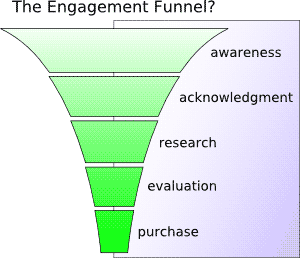It all started with a comment from Debbie Raymundo, the Retail Marketing and POS Manager at Motorola. She was talking about a relatively recent innovation for tethered displays -- those retractable wires glued on to cell phones, iPods and other small gadgets that let you handle the product, but not walk off with it. Apparently, new display systems will actually keep track of every time you pick up a particular item, figure out how long you handle it, determine whether you also pick up other items, and so on. At the end of the day, this data can be reconciled with sales data to determine whether a certain product gets handled a lot but not purchased, for instance. Raymundo mentioned an example where shoppers might pick up a Motorola phone much more frequently than a Nokia, but the Nokia outsells it. This could indicate that the Nokia is being promoted more effectively or the sales staff has a bias towards it (or perhaps they get additional compensation from the manufacturer). Without this "interaction" data, it's hard to tell if the problem stems from the product itself or arises from other factors like marketing and promotion. With the data, at least the manufacturer has a place to begin. In the previous example, Motorola knows they're doing a good job getting customers to pick up the phone and try it out, so the brand recognition is there, and initial product design is appealing, but something else is making people abandon the product after that initial interaction.
Granted, this kind of information has been available for a while, but manufacturers and retailers had to collect it manually. Paco Underhill's company Envirosell still deploys legions of retail field workers (think anthropology, not picking fruit) to observe shopper behaviors and studiously record these actions using codes and shorthand. The company often monitors between several hundred and several thousand customer visits this way, and then combines this data with video footage to put together a comprehensive analysis of shopper habits. Both this method and the more automated one above have advantages and disadvantages. For example, the tethered display system will track every single time a product is handled, along with the exact product make and model. Since it's automated, it can be deployed to every store in a chain at a fairly reasonable cost. However, the information is one-dimensional, and even thoughtful analysis might produce incorrect conclusions simply because there's no corroborating data. (For example, what questions did the customer ask the sales clerk while handling the item?) On the other hand, the retail anthropology technique yields a much more complete picture of individual shopper behaviors and can illustrate complex decision making processes that might otherwise not be obvious. But this method takes a lot of time and manpower, and is more expensive to scale.
 So behavioral measurement and analysis is a good thing. We knew that. The question is: can we make this data even more valuable by measuring the store's media components? We can't pretend that watching a spot on a digital sign is equivalent to actually handling the product, can we? But what about the shopper that requests an infomercial-style spot from a kiosk? Does one of these actions signify engagement, while the other does not? From what I've read and heard, people seem to use the engagement term as a sort of dividing line. In other words, people who aren't engaged stand on one side of the line, those who are engaged stand on the other, and nobody straddles the line. This is clearly wrong -- there are so many different ways that a customer might discover, contemplate and interact with a product that we'd need something more like the marketing funnel diagram from our digital signage ROI series to describe it. As you can see on the left, I've taken a stab at what this might look like if we focused on the engagement side of things.
So behavioral measurement and analysis is a good thing. We knew that. The question is: can we make this data even more valuable by measuring the store's media components? We can't pretend that watching a spot on a digital sign is equivalent to actually handling the product, can we? But what about the shopper that requests an infomercial-style spot from a kiosk? Does one of these actions signify engagement, while the other does not? From what I've read and heard, people seem to use the engagement term as a sort of dividing line. In other words, people who aren't engaged stand on one side of the line, those who are engaged stand on the other, and nobody straddles the line. This is clearly wrong -- there are so many different ways that a customer might discover, contemplate and interact with a product that we'd need something more like the marketing funnel diagram from our digital signage ROI series to describe it. As you can see on the left, I've taken a stab at what this might look like if we focused on the engagement side of things.Ultimately, I stand by my original conclusion that the best measurement technique is running well-controlled A-B split tests and correlating the results with register receipts. But people are clearly excited about gaze tracking, traffic pattern analysis, and the like. So my question for all of you savvy, experienced and brilliant people out there is this:
What value does behavioral measurement (whether gaze tracking or otherwise) bring to the retail environment? Is it simply easier than running controlled experiments, or does it provide some additional insight that translates into improved sales?
Leave a comment below and let me know your opinion. If you're reading this article via email or you're using a program like Bloglines or Google Reader, click the link below to access the comment form.

 Subscribe to the Digital Signage Insider RSS feed
Subscribe to the Digital Signage Insider RSS feed
Comments
RSS feed for comments to this post